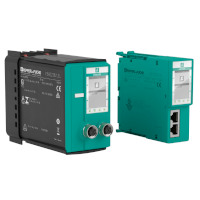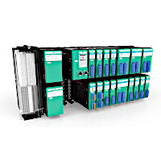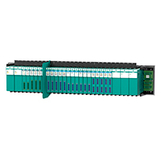Remote I/O—Bridging Two Technologies
The advantage of the clear assignment of a signal to a terminal, while integrating existing instrumentation and wiring, in combination with the significantly reduced wiring effort by the use of a bus interface to the control system—remote I/O benefits from the best of two technologies. Therefore it is the ideal and most cost-effective way for the modification or modernization of process plants.
Modular remote I/O systems transmit process data from safe or explosion hazardous areas by connecting binary and analog sensors and actors to the control system via a bus interface. Remote I/O is the right choice when you want to put I/O modules close to the field devices. Due to the reduced wiring effort, you not only save cables, but also time, money, and work effort. Hence, remote I/O field units can be installed in a decentralized location inside hazardous areas while you easily control and monitor sensors and actors from the control room.
You can connect 4 mA … 20 mA devices to remote I/O, including water flow transmitters, valve positioners, pressure transducers, or temperature transmitters. Devices such as thermocouples, resistance temperature detectors (RTDs), mechanical contacts, and visual or audible alarms may also be connected.
Our remote I/O systems are compatible with network protocols like:
- PROFIBUS DP
- PROFINET
- MODBUS RTU
- MODBUS TCP/IP
The two systems offered by Pepperl+Fuchs for the use in Zone 1 or Zone 2, the FB remote I/O- and the LB remote I/O system, have another, very important benefit to offer: keeping the topology of both systems the same across the process control level simplifies planning and carrying out maintenance.
The Gateway to IIoT

The seamless integration of device and process data is a basic requirement of IIoT applications, as well as the handling of big data. By using Ethernet-based communication, the remote I/O PROFINET gateway meets these demands and provides an easy-to-manage, high-performance solution. Building a bridge between the field level and Ethernet-based network structures, it connects any LB and FB station with PROFINET networks.
The Shared Device function, which is standardized for PROFINET, allows several PROFINET controllers to have simultaneous read access to the data of the PROFINET gateway and thus to the field devices. Actuators of a remote I/O unit can each be assigned to different controllers. Dynamic Reconfiguration allows the I/O modules to be reconfigured or even changed during operation without stopping the PROFINET controller.

FB remote I/O is certified for mounting in Zone 1, placing the remote I/O system close to field devices, and it is installed in an enclosure. This modular signal conditioning system allows you to interface signals from the field with a control system located in the non-hazardous area via Ex i or Ex e field connections. As new green series, this tried and tested system is presented in a completely refurbished, new design with well thought-out features.

LB remote I/O is certified for mounting in Zone 2, Class I/Div. 2 explosion-hazardous areas. This modular signal conditioning system allows you to interface signals from the field with a control system in the non-hazardous area via Non-Ex or Ex i connections. Both circuit types can be mixed in one system. The LB remote I/O system is plugged into a backplane. Alternatively, our Solution Engineering Centers (SECs) can provide the system pre-mounted into a fully certified custom enclosure.







 +27 87985 0797
+27 87985 0797